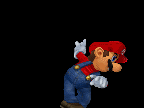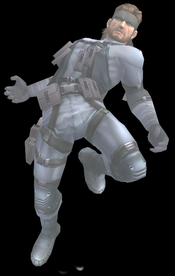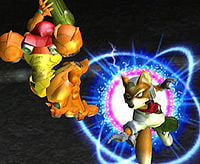Air dodge
An air dodge (or EscapeAir by internal Brawl files) is a technique in Super Smash Bros. Melee, Super Smash Bros. Brawl and Super Smash Bros. 4 that gives temporary intangibility frames to the user in the air, preventing attacks from hitting them. It can be described as sidestepping in midair.
In Super Smash Bros. Melee
In Melee, an air dodge is performed by fully pressing the L or R button while in the air. Air dodges cannot be done if the character is tumbling or reeling. The air dodge halts the character's momentum; it leaves the character hovering if the Control Stick is not tilted, and when the Control Stick is tilted, the air dodge gives the character a small boost in its direction. This boost can aid one's recovery, though most air dodging characters cannot sweet spot the ledge. Furthermore, most third jumps outreach the air dodge, making it more beneficial for sweet spotting the ledge in most situations.
During the air dodge, the character cannot be hit by attacks, but then enters a helpless state and falls to the ground. While air dodging, pressing the attack button while holding the shield button also allows the player to grab any nearby items, as well as use grab aerials with characters that have one: this is known as air dodge grabbing.
Air dodging into the ground is known as wavelanding, which is the primary component of the wavedash.
Using air dodges as a recovery

An angled recovery is the opposite of wavedashing, since the player angles the control stick up. An angled recovery is useful when a player gets knocked off a stage that has multiple platforms, such as Temple.
In order to perform an angled recovery, the player must hold the control stick up diagonally and air dodge. The angled recovery has less lag time compared to a character's normal recovery and it can't be negated since the player is intangible, but it generally doesn't go as far as a character's usual recovery move. The angled recovery is useful when the player is at the peak of their second jump from a short vertical distance off the side of the stage and a short horizontal distance. If the player is too far away, they will fall and receive a self-destruct. The player can also perform this at far distances only if they're at a very high altitude. The angled recovery is effective when the character's second jump isn't enough to make it back to the stage, but is close enough for where an air dodge will cover the remaining recovery distance.
While angled recoveries do not provide more height or distance than standard recovery options, they still see use by multiple characters in the cast. Jigglypuff, Yoshi, and a solo Popo/Nana benefit from the tactic due to their up B attacks not giving any recovery distance, and in the cases of Jigglypuff and Popo/Nana, more than their side B. In addition, while Samus, Link and Young Link boast relatively long and flexible recovery options, the angled recovery can allow for the trio to use their wall-grapple during the ascent of the dodge; as players can air dodge in any direction, it can also be used to get the character closer to the stage in order to decrease their distance from a wall. Outside of this, most of the cast may elect to use angle recoveries in order to combat some edgeguard techniques that do not include edgehogging; air dodging into a ledge, for instance, can counter a player who is charging an attack on the edge of a stage.
Air dodge intangibility and animation length in Melee
Grabbing the ledge is possible as soon the animation length is over.
| Character | Animation length | Intangible frames | Intangible duration |
|---|---|---|---|
| Dr. Mario | 48 | 4-29 | 26 frames |
| Mario | 48 | 4-29 | 26 frames |
| Luigi | 48 | 4-29 | 26 frames |
| Bowser | 49 | 3-29 | 27 frames |
| Peach | 49 | 4-19 | 16 frames |
| Yoshi | 49 | 4-29 | 26 frames |
| Donkey Kong | 49 | 4-29 | 26 frames |
| Captain Falcon | 49 | 4-29 | 26 frames |
| Ganondorf | 49 | 4-29 | 26 frames |
| Falco | 49 | 4-29 | 26 frames |
| Fox | 49 | 4-29 | 26 frames |
| Ice Climbers | 48 | 4-29 | 26 frames |
| Ness | 48 | 4-29 | 26 frames |
| Kirby | 49 | 4-29 | 26 frames |
| Samus | 49 | 4-29 | 26 frames |
| Zelda | 49 | 4-19 | 16 frames |
| Sheik | 49 | 4-29 | 26 frames |
| Link | 49 | 4-29 | 26 frames |
| Young Link | 49 | 4-29 | 26 frames |
| Pichu | 49 | 4-29 | 26 frames |
| Pikachu | 49 | 4-29 | 26 frames |
| Jigglypuff | 49 | 4-29 | 26 frames |
| Mewtwo | 39 | 4-29 | 26 frames |
| Mr. Game & Watch | 49 | 4-29 | 26 frames |
| Roy | 49 | 4-29 | 26 frames |
| Marth | 49 | 4-29 | 26 frames |
In Super Smash Bros. Brawl
In Brawl, the air dodge has been revamped. It no longer halts the character's momentum and no longer permits the user to nudge the character by pressing the control stick. It simply grants brief intangiblity along the character's current line of movement. Following the air dodge, characters are put in their regular aerial state rather than the helpless state, and thus may attack, jump, or air dodge again following their initial air dodge. It is also possible for characters to air dodge 15 frames after being hit, regardless of total recieved hitstun.
The air dodge can now also be used when a character is tumbling or reeling, and is often employed by players to enable action quicker than waiting out their knockback and to limit reliance on teching. Using the air dodge at this time does not reduce knockback, a rumor that was started when it was noticed that higher-level CPUs were doing it constantly. However, an air dodge can be used for momentum canceling, and in some cases, such as Ike and Snake, it is their best option, since they yield better results using an air dodge when momentum canceling than their shortest-lasting aerial (both of their air dodges end in 39 frames, while their shortest-lasting aerials last just a few frames longer, and despite the miniscule difference, air dodging is still their best option nonetheless). In addition, they also gain the most benefit when momentum canceling using the basic method.
Air dodges now cause characters to automatically catch any item nearby during the first frames (unless they are holding one already), without having to press the attack button like in Melee. However, this also means characters can no longer grab items at any time of the air dodge, only the beggining.
Air dodge intangiblity and lag in Brawl
The table here displays the frame data for the air dodge of every Brawl character. Every character has a certain amount of frames taken to perform an air dodge, and the intangibility frames starts and ends in between the total frames taken. Most characters' intangibility usually starts on frame 4 and end about 10 or 20 frames before the end of the entire air dodge; however, there are a few exceptions.
| Characters | Intangibility Frames | Total Frames |
|---|---|---|
| Meta Knight | 3-29 | 39 |
| Zero Suit Samus | 4-29 | 39 |
| Diddy Kong | 4-29 | 39 |
| Pit | 4-29 | 39 |
| Squirtle | 4-29 | 39 |
| Ivysaur | 4-29 | 39 |
| Charizard | 4-29 | 39 |
| Ike | 4-29 | 39 |
| Snake | 4-29 | 39 |
| King Dedede | 4-29 | 39 |
| Lucario | 4-29 | 39 |
| Wario | 4-29 | 39 |
| R.O.B. | 4-29 | 39 |
| Olimar | 4-29 | 39 |
| Ice Climbers | 4-29 | 48 |
| Ness | 4-29 | 48 |
| Sonic | 4-29 | 48 |
| Lucas | 4-29 | 48 |
| Bowser | 4-30 | 49 |
| Mario | 4-29 | 49 |
| Donkey Kong | 4-29 | 49 |
| Link | 4-29 | 49 |
| Samus | 4-29 | 49 |
| Kirby | 4-29 | 49 |
| Fox | 4-29 | 49 |
| Pikachu | 4-29 | 49 |
| Mr. Game & Watch | 4-29 | 49 |
| Luigi | 4-29 | 49 |
| Zelda | 4-29 | 49 |
| Sheik | 4-29 | 49 |
| Falco | 4-29 | 49 |
| Yoshi | 4-29 | 49 |
| Ganondorf | 4-29 | 49 |
| Wolf | 4-29 | 49 |
| Toon Link | 4-29 | 49 |
| Captain Falcon | 4-29 | 49 |
| Jigglypuff | 4-29 | 49 |
| Marth | 5-30 | 49 |
| Peach | 4-19 | 49 |
In Super Smash Bros. 4
In Smash 4, air dodges have significantly less ending lag than in Brawl, now lasting from 28 to 34 frames (depending on the character), compared to the previous games' 39 to 49 frames. This allows characters to execute many air dodges in quick succession to avoid attacks, as well as safely use attacks out of them; players can now jump, go through an opponent's attack with an air dodge, then retaliate with an attack or their own. This is especially beneficial for characters with quick aerial attacks, as they can do them along with an air dodge in a short hop. Jigglypuff also finds easier opportunities landing its Rest with this technique. However, air dodges now produce a significant landing lag of 22 frames as the character lands with an air dodge active, even during vulnerability frames, making air dodges easier to punish on land, and thus riskier to use close to the ground. To prevent this, some characters can use an aerial attack in order to replace the air dodge's landing lag with the aerial's autocancel, a technique known as "dodge cancelling", though this requires precise timing. Unlike Brawl, however, it isn't possible to perform an air dodge while in hitstun - resulting in combos being easier, but safe juggles being more difficult to pull off.
Both the shield button and the grab button (when used in midair by a character without a zair) allows players to air dodge. In past installments, the grab button would cause the fighter to use a neutral aerial.
Air dodge intangibility and lag in Smash 4
The table here displays the frame data for the air dodge of every character in version 1.1.0 of both Super Smash Bros. for Nintendo 3DS and Super Smash Bros. for Wii U. Before version 1.0.4 of Smash 3DS, Wii Fit Trainer had only 12 landing lag frames from an air dodge, while Zero Suit Samus had 15; these were later changed to the standard 22 frames used for all other characters.
| Characters | Intangibility Frames | Total Frames |
|---|---|---|
| Mewtwo | 2-24 | 28 |
| Fox | 2-25 | 30 |
| Little Mac | 2-25 | 30 |
| Meta Knight | 2-25 | 30 |
| Pikachu | 2-25 | 30 |
| Sheik | 2-25 | 30 |
| Sonic | 2-25 | 30 |
| Toon Link | 2-25 | 30 |
| Zero Suit Samus | 2-25 | 30 |
| Dark Pit | 2-26 | 31 |
| Diddy Kong | 2-26 | 31 |
| Duck Hunt | 2-26 | 31 |
| Falco | 2-26 | 31 |
| Greninja | 2-26 | 31 |
| Mr. Game & Watch | 2-26 | 31 |
| Pit | 2-26 | 31 |
| Wii Fit Trainer | 2-26 | 31 |
| Lucario | 2-25 | 31 |
| Dr. Mario | 3-27 | 32 |
| Kirby | 3-27 | 32 |
| Lucina | 3-27 | 32 |
| Luigi | 3-27 | 32 |
| Mario | 3-27 | 32 |
| Marth | 3-27 | 32 |
| Mii Brawler | 3-27 | 32 |
| Mii Gunner | 3-27 | 32 |
| Olimar | 3-27 | 32 |
| Pac-Man | 3-27 | 32 |
| R.O.B. | 3-27 | 32 |
| Rosalina | 3-27 | 32 |
| Roy | 3-27 | 32 |
| Samus | 3-27 | 32 |
| Wario | 3-27 | 32 |
| Bowser Jr. | 3-28 | 33 |
| Captain Falcon | 3-28 | 33 |
| Charizard | 3-28 | 33 |
| Ike | 3-28 | 33 |
| Link | 3-28 | 33 |
| Lucas | 3-28 | 33 |
| Mega Man | 3-28 | 33 |
| Mii Swordfighter | 3-28 | 33 |
| Ness | 3-28 | 33 |
| Palutena | 3-28 | 33 |
| Peach | 3-28 | 33 |
| Robin | 3-28 | 33 |
| Shulk | 3-28 | 33 |
| Villager | 3-28 | 33 |
| Yoshi | 3-28 | 33 |
| Zelda | 3-28 | 33 |
| Bowser | 4-29 | 34 |
| Donkey Kong | 4-29 | 34 |
| Ganondorf | 4-29 | 34 |
| Jigglypuff | 4-29 | 34 |
| King Dedede | 4-29 | 34 |
| Ryu | 4-26 | 34 |

